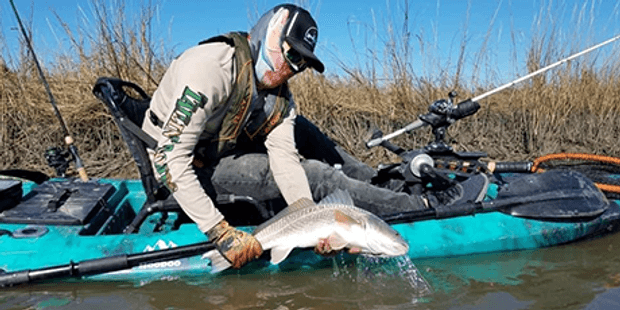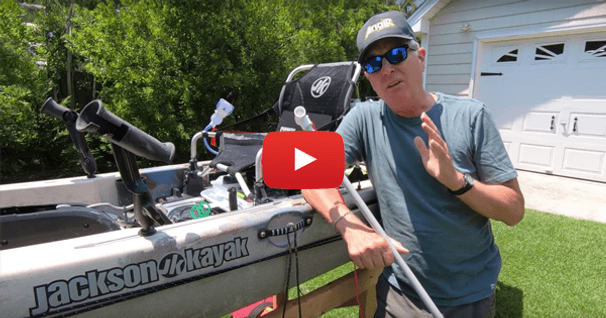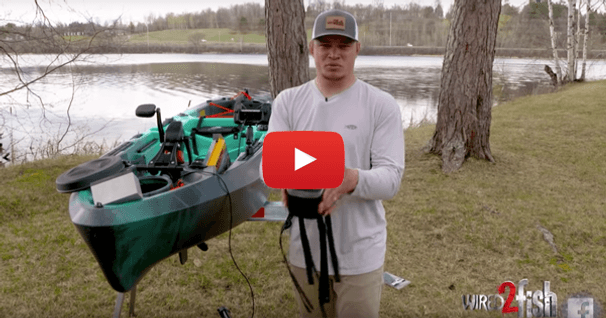Fishing From a Traditional Kayak
Fishing from a "touring" kayak, whether it be a sleek, blue-water craft or a broad and stable "rec" boat, has always been one of the complementary pleasures of kayaking. For thousands of years, native cultures along North America's northern coastlines have used kayaks as a primary means of gathering food from the sea. Long before the sit-on-top, floating-tackle-box craze bloomed as the latest answer to "kayak" fishing, paddlers had challenged inland waters as well as bays, estuaries, kelp forests and rocky shelves just off shore to catch a wide variety of fish.
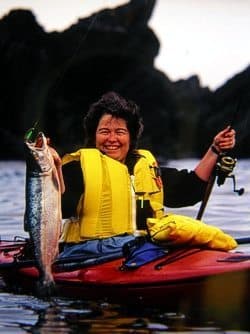
Rigging one's kayak for fishing is a simple matter of basic need, convenience and always – safety! An important aspect to rigging a kayak for fishing is the desire to make it temporary so as to maintain the uncluttered sleekness of a clear deck and coaming area. The fishing-rigged SOTs serve a grand purpose for the serious angler who wants/needs a plethora of gear at his/her immediate disposal. Many accessories are either themselves permanently attached to the boat or are easily nestled into a base that is then permanently attached. Some "fishing" models are so gadgeted up that even when stripped of gear, the harnesses, brackets and holders clutter the decks and recesses of the crafts.
In my mind, fishing from a standard touring boat is a matter of temporarily outfitting your boat with the essentials needed for a frontal, floating assault on your game fish of choice. Most anglers know that there are a few essentials to fishing: a line, a hook and bait. Everything else supplements that list in varying degrees.
Fishing rods are a matter of taste and the type of fish one anticipates catching and landing. I've seen successful kayak anglers use everything from stout cranking sticks to delicate, featherlight fly rods – all with satisfying success.
The most common debate around fishing rods seems to always center on length. Some suggest a short rod that is easy to stow on deck, doesn't get in the way and is quite adequate to haul in a variety of fish. A stubby rod might work well for bluegills, sunnies and crappies and maybe even a hot walleye glory hole off a gravel point. Catching northerns, bass and wild ocean salmon requires a longer rod that you can swing 360°, across the bow and completely behind and around the stern. These and other species will dart and dip deep under your boat, racing from side to side in their fight to get free. The argument for short rods is that you can simply "pass the rod under the boat from one hand to the other and keep on the fish" Right!
~Fishing Kayaks from Hoodoo Sports~
Looking for a high quality fishing kayak at a reasonable price? Check out Hoodoo's lineup featuring the new dual-drive Impulse.
Eagle Claw's break-down rod kit, the TrailMaster has been one of my most used pieces of gear for 40 years. Essential for backpacking, the five-piece rod (spinning or fly) easily stows on deck to quick assemble whenever fishing is an option. www.eagleclaw.com
Reels are a personal choice as well. I prefer an open-face spinning reel for 99 percent of my fishing. And those who insist you can't fly fish from a traditional kayak are usually neither adept at that artful technique nor seasoned kayakers!
Bait in kayaks sounds like a stinky idea waiting to get even worse! However, artificial baits can be as effective as the real thing (tho' nothing beats a fat night crawler for most anything worth catching!). Attractive lures or special flavorings impregnated into synthetic squirming critters give you way too many choices from which to choose!
The rest of the gear list is mostly a matter of preference. Here's what I like to use - gear and techniques - when fishing from my 17' touring kayak:
Assuming my angling will successfully move from "fishing" to "catching", I need a way to both retrieve and keep my catch. A short handled landing net is handy, especially those with a longer, narrower net frame instead of the standard teardrop design. The key for this and most gear is a secure placement on your deck with easy access and without compromising safety (entanglement, imbalance, etc.). I rarely use a net as I've found an easier way to hang on to a nice 'keeper'. If you are considering a net, Frabill offers a wide variety of full-size, compact, fold-down featuring Tangle-Free and clear net options. Check out their "trout/kayak net" at www.frabill.com.
I use a chain stringer, those with the series of shower curtain-like hooks on a small chain. The anchoring end clips to a D-ring on my kayak while the series of hooks are loosely piled on my deck (nestled against a bungee or other piece of deck gear). The first hook on the chain is unclipped and ready to go. Once I bring a larger fish up to just below the surface I grab the open stringer clip and quickly hook the fish through their lower jaw. I then clip it shut and drop the stringered fish into the water – all done using a series of quick motions that never requires the fish from being pulled up through the surface.
A word of caution to those who use this method in waters that harbor giant "fishivores": secure your stringer to your boat with a break-away knot or quick release. In the event your small catch becomes a morsel to a larger fish – or even sea lion as happened to me once during an idle afternoon of fishing for rock fish in Alaska – you might avoid an unpleasant and potentially dangerous capsize.
A small tackle box containing a few compartments for a variety of lures, hooks, and other pieces of hardware is usually all one needs for a day of fishing. Extra tackle can be stowed below deck. A bungee can hold the mini tackle box – or even live bait containers -in place for easy reach. A handy deck bag for kayak fishing that works well is Granite Gear's Wedge Thwart Canoe Bag. Initially designed for canoes, the thwart bag has straps adequately placed to easily loop around foredeck bungees just beyond the cockpit so the zippered pockets running the entire length of the bag are easily assessable. Tackle box, other fishing hardware, camera, bait tin are all within reach. A flexible insert serves as a bag stiffener as well as a removable cutting board atop your sprayskirt. www.granitegear.com
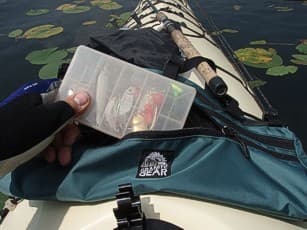
For me, that's the extent of my "must have" list. However, my comfort zone can be enhanced with several gadgets that make the fishing experience even more satisfying.
Sometimes I don't use my sprayskirt as I may need to drop a fish down into my cockpit. I advise bringing a large plastic bag to keep fish slime to a minimum. However, having a work/splash surface at least in the front half of your cockpit is very handy for fishing. You can accomplish this by using a spray deck – a half skirt. SEALS makes one that includes a zippered mesh pocket and an adjustable bungee cord rim. The half skirts are handy for keeping your upper legs shaded and dry, too. www.sealsskirts.com
A proficient kayaker has usually learned several ways to balance a paddle on deck while engaged in other two-hand maneuvers. The Yakclips and multi-color coiled Paddle Leash from Cascade Creek offer two other means for conveniently keeping track of your paddle. The flexible clip attaches to your coaming for a quick snap to hold it across or alongside your cockpit. The elastic tether works like any leash allowing stretch and motion while paddling plus a line to keep it from drifting away should you lose or jettison it overboard. Like any tethering to a kayak – always think safety and entanglement possibilities. I am not a fan of tethering but a leash has its place. CC's coiled leash also worked well as a rod tether and did not impede casting at all.
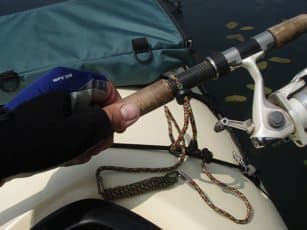
They also make a sturdy, versatile detachable rod holder for attaching to both a canoe's gunwale and a kayak coaming. No holes to drill, no permanent base to get in the way. A rotating ring secures the rod while enabling quick retrieval when you’ve got a fish on. www.cascadecreek.com
I rarely use an anchor when kayaking; even the small one for my canoe is just too bulky and heavy. Apparently the gang at Squid Anchor has felt my pain! Their Squid (recommended for canoes) and smaller "Shrimp" (kayaks) folding anchor bags are ideally suited for use in small watercraft. The concept is simple: design a durable bag that can be loaded with weight rocks/ gravel/sand from shore), add a few flukes to clawhold the bottom, attach a line and - voila! - a portable, foldable sea kayak and canoe anchor!
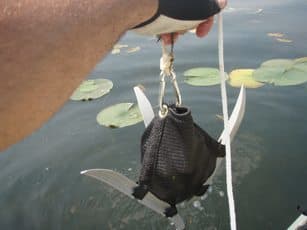
Reinforced grommets along the upper edge of the bag enable you to either thread an anchor line through the top or use a carabiner/clip to close the top. The smaller "Shrimp", when loaded with about six pounds of rocks was easy to retrieve from even a weed-covered bottom after holding the kayak completely drift-free in a moderate, steady lake breeze. The reinforced fiberglass anchor flukes are tucked into the bag for easy- no scratch storage on deck.
I have it on good authority that the larger canoe anchor can also hold up to three cans of liquid refreshment – a quickie cooler to lower to the refreshingly colder water at the bottom of a lake!
www.TheSquidAnchor.com
Sometimes retrieving an anchor mimics a small scale dredging operation in a weedy lake. The anchor rope can do a number on your hand. A half glove can be a real palm saver when fishing. The padding protects your soft areas while your open fingers are free to manipulate gear, knots and other finite tasks. Boaters Gloves by NRS have reinforced leather palms attached to comfy stretch nylon that is durable and fast drying. I didn't even feel them after a few short minutes of paddling and the extra grip I was able to exert on my anchor line didn’t even hint at sore palms after a weed-grabbing tug-o-war. www.nrsweb.com
One last suggestion to those of you who are tied to technology even on the water. You may get by without a depth finder or temperature gauge, but you may surely want to stay connected with cyberworld. You may need to consider a LifeProof case for your iPhone 4/4S. It's a sleek, protective holder boasting "unlimited outdoor use". That claim is backed by its ability to function to depths of over six feet as well as impervious to rain, snow, dust and the sudden impacts of the outdoor scene. The case has an adapter for a GoPro camera mount and comes with an armband/swim band for on/in-water use. You can certainly take it fishing with you. Details and specs at www.lifeproof.com.
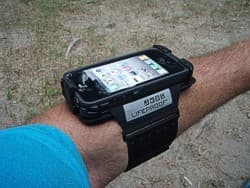
Whether you are an avid angler who wants to try fishing as an option while paddling or a kayaker who enjoys wetting a line as one of the many companion activities while on the water, fishing is essentially an endeavor onto itself. You can catch all the fish you want with basic tackle. As you develop proficiency with your watercraft, you will know what works and what doesn't, what to bring and where to put it - and to do so safely and effectively. It is important to have good paddling skills when fishing from a kayak. Sculling and bracing strokes can help move you around and keep you upright.
Fishing can be a great way to introduce kids to kayaking. Most import, whether you are going to be fishing for lunker bass in a weed bed just down from the dock or tempting a salmon from an Alaskan bay, wear proper gear, be safe and have fun!
Tom Watson is an avid sea kayaker and freelance writer. For more of Tom's paddling tips and gear reviews go to his website: www.wavetameradventures.com. He has written 2 books, "Kids Gone Paddlin" and "How to Think Like A Survivor" that are available on Amazon.com.
Related Articles
Learn to make a good DIY stake out pole so you can save some money for other kayak updates!
Learn how to install a fish finder on your fishing kayak without compromising your yak by drilling holes…
I had an opportunity last week to go on a different type of fishing adventure. This trip would be to…
I don't know about you, but I'm ready to get outside! Up until now, old man winter has been pretty kind…
